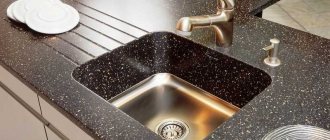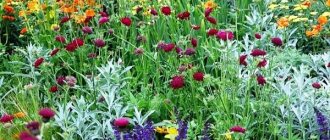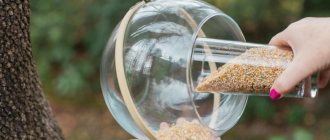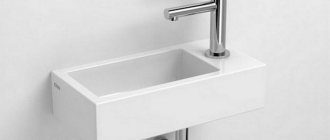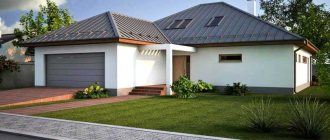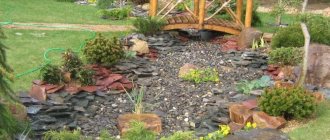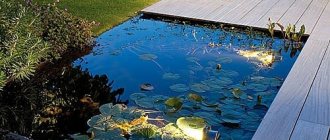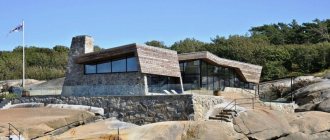Garden ideas never end for those who love their own paradise in the sun, the official name of which is dacha. In this case, working on the site is a pleasure, an anticipation of the results.
Starting with simple designs, we increasingly complicate the tasks. Although the implementation of the majority only seems difficult. For example, many people think about how to make a beautiful waterfall in their country house with their own hands, and do not even realize that this task is actually very simple.
The simplest waterfall diagram
Regardless of which model is chosen for construction, absolutely any option has a general design and includes:
- Pump and water pressure system.
- Bowl or pool.
- Internal water discharge system.
In addition, garden waterfalls are characterized by additional decorative finishing.
Stage 1 - choosing the shape and depth of the structure
The shape of the pond into which water from a man-made waterfall will fall can be any shape. If you like clear geometric shapes in garden architecture, the pond can be made round or rectangular. If you prefer natural forms, the contours of the bowl can have any shape, just not too complex so that it is convenient to carry out construction work.
The pond may be shallow if you do not plan to have fish or underwater plants in it. If you want the pond to delight you with underwater flora and fauna, its depth should be at least a meter, or better yet deeper, so that fish and plants can overwinter without freezing.
Materials for building a waterfall
The most popular garden waterfall model today is the version made of natural stone. For construction you will need the following materials:
- Decorative rock.
- Sand.
- Pebbles.
- Cement.
- Materials for waterproofing.
- Pump.
- Primer.
- Set of tools.
Construction of a reservoir for a waterfall. Master Class
- Mark on the ground the shape of the future reservoir. It is convenient to do this with spray paint, although you can simply mark it with a shovel.
- Dig a hole.
- If you are making a small reservoir for a waterfall, you can put some kind of container in the hole. For example, an old basin or bathtub. Fill the voids around the container tightly with sand and crushed stone.
- When building a larger tank, you can simply line the bottom of the pit with film. A more difficult option is to concrete the hole. How to deal with this, see here.
- Fill the pond with water.
- We decorate the bowl with stones, visually connecting it with a stone hill from which water will fall.
The film will protect the soil from washing out
A concrete bowl for a waterfall will allow you to create different rocky shapes. The shape of the future waterfall is revealed. This waterfall in the courtyard of the house is made in the Japanese natural style. Mosses on the stones are a spectacular move.
A wonderful water structure on the site - a piece of nature
Requirements for the location of the waterfall
When constructing a decorative structure, a number of requirements must be observed:
- You should not build a waterfall next to residential or commercial buildings. Constant exposure to moisture can damage the structure of the walls and shorten the life of the building.
- Before starting work, you must make sure that there are no large trees or bushes near the construction site. If there are any, it is necessary to get rid of them, since plant roots can destroy the frame of the waterfall.
- It is advisable to arrange a shady cover for the bowl of water - constant exposure to sunlight will lead to algae blooming and bacterial growth. In this case, an unpleasant odor and color of the water will quickly appear.
By observing just a small list of conditions, you can decorate your summer cottage with a beautiful and original decorative waterfall.
Base for rocky part
- We mark out an area on the ground for the rocky part.
- We remove the soil to a depth of about 40 cm.
- We fill 1/4 of the depth with stones, rubble, pieces of broken brick, etc. We do not use sand-lime brick (it attracts moisture) or wood waste (it rots quickly).
- We fill the pit with a mixture of sand and crushed stone - as a result, we get an excellent drainage cushion.
- We install several large stones.
- We pour the earth, forming a hill. Add stones to prevent the earth from crumbling. It is advisable to pre-treat the soil with herbicides against weeds.
- We water and compact each layer of soil.
Stones of different sizes - just like in nature
Great combination of rocks and water
Such a water structure can become the pride of the garden. Water flows over flat stones
Flat stones look good in the above-ground part of the waterfall
Laying stones to create the shape of a waterfall
Sheer waterfall - an interesting effect
The stones do not have to be large.
To construct the rocky structure into which the waterfall will be built, we use any natural stones. You can choose stones that are approximately the same in color and size, or completely different ones to get a mixed picture.
Porous limestone, shell rock, and calcite actively absorb moisture, which is why they collapse. They can be used to decorate a waterfall, but it is advisable that they do not come into contact with water.
If you are making a cascade waterfall, use flat stones.
Types of waterfalls
There are several main types of decorative waterfalls:
- Classic cascade model.
- Dry waterfall.
- Original decorative waterfalls.
Each option has its own design and location features, but the drawings are freely available.
What stones should you choose for an alpine slide?
Stones and plants for an alpine slide are the core of its design, so their choice must be taken seriously.
First, you need to decide on the size of the alpine slide and start from there. If the alpine slide is large, you can use large boulders, otherwise (if the slide is approximately 5m*3m) small stones and flagstone are used.
Stones for an alpine slide are the key to an effective design
When choosing stones, pay attention to their shape and appearance, because... these criteria will be noticeably reflected in the overall design of the slide
Laying stones should be carried out in tiers, no less than 3, but no more than 5. Don’t be afraid to experiment and embody the most vivid manifestations of your imagination: create patterns from stones, make a stone composition, etc.
Remember that in winter and early spring the alpine hill will not delight you with flowering plants, so the stones should create an attractive appearance even without additional decorative elements.
You should not make large distances between the stones, because... the created alpine slide may seem bald, but at the same time, do not forget to leave room for ornamental shrubs and flowers.
Avoid perfect symmetry in the arrangement of stones, because... the general appearance should resemble a piece of a natural area untouched by human hands.
As for the placement of the stones itself, it should be noted that the most massive boulders should be installed at the foot of the hill, and small stones should be placed closer to the top.
Among all the stones, choose the most attractive and original one to install it on the top of the alpine hill.
This, in fact, is all I wanted to tell you about the component of the alpine hill - the stones, now let's move on to the next important element - the plant world
dry waterfall
The technology for constructing a dry waterfall has a peculiarity - the water bowl is hidden under the ground, a pile of stones or sandstone. The water flow, descending, “disappears” into a hidden reservoir.
For this model, a pit is also prepared for the bowl, but on top it is covered with a metal mesh with a filter to prevent possible contamination and dirt.
We install pumping equipment for a waterfall
Based on the size of the water structure, we purchase pumping equipment for the waterfall. The larger the structure, the more power the pump needs.
Set of equipment for a waterfall in the garden
We direct the hose upward and hide it together with the nozzles between the stones.
Water nozzles can be of different shapes and sizes; we use them to form jets.
It is better to purchase waterfall equipment with a water filter
Equipment layout for a waterfall
Illuminated garden ponds are spectacular. The best solution is solar-powered lights. To ensure their operation, there is no need to lay an electrical cable - the batteries are charged during the day and illuminate the pond with a waterfall at night.
Illumination of the water structure makes it especially beautiful in the evening Solar-powered lanterns do not require power supply
Miniature waterfall with bowls made from ceramic pots
When creating, a set of ceramic flowerpots of various sizes with dense walls is used. The voids between the nested containers are filled with fine gravel or crushed stone.
The pump is located at the very bottom of the structure, and the nozzle passes through all the pots through an artificial channel.
Stones: which ones and where to get them
The basis of any type of slide is stones and you will need a lot of them - several tons, and of different sizes. Choose from those breeds that are more common in your area. Chopped blocks look best, but already aged, with dark edges. You can also use pellets with smooth sides, but creating a natural composition from them is not an easy task. You will need about one fourth of a large size, about the same amount of a medium size - the rest are small stones.
Granite looks great. But it is hard and “cold”; even the most tenacious saxifrages can rarely grow on it, and the soil next to it quickly acidifies. This should also be kept in mind and periodically adjust the acidity (or plant plants that love acidic soil).
Stones in the form of slabs look good on low slides
It is best to use tuff. It drains water well, water flows through it well, and what’s even more important is that plants grow well right on it
What’s also important is that it neutralizes acidity, which the “Alpines” like.
Lime slabs are also good, but they come in slabs; they are good for decorating alpine plains or very low and gentle hills.
An original waterfall made from old metal bowls, cauldrons and a jug
The main elements are installed on pedestals (you can use decorative driftwood or a slide made of plastic), and the water supply system is routed through all containers. A large cauldron is installed at the very bottom, which acts as a bowl. All metal surfaces must be treated with an anti-corrosion coating before construction.
How to choose plants for an alpine hill
The choice of plants for a rock garden must be thought out in advance, since each type of landscape is suitable for one or another set of representatives of the fauna world, for example, rock gardens on slopes are characterized by creeping species, and valleys are characterized by flowering types. Experts advise choosing representatives of the flora that bloom in different periods, so that the alpine slide can please the eye for a long time. Perennials, in most cases, bloom in the fall. This could be lavender, geranium, saxifrage, etc. Their growth requires careful monitoring, since heavily overgrown crops can block sunlight for shorter plants. Bulbs (crocuses, hyacinths) bloom in the spring, and in winter, coniferous species - thujas, some varieties of spruces, etc. - will not allow the landscape to be empty.
On the alpine hills there are also low-growing shrubs, such as Japanese maple, rosemary, azalea, and dwarf roses. Among herbaceous representatives, you can choose thyme, bells, marigolds, and edelweiss, phlox, and dwarf ferns are also often planted on the hills. Ground cover daisies, St. John's wort, and yarrow will perfectly cover the empty spaces between the stones.
When planting, you need to take into account one of the important rules: low-growing species are planted in groups, and lush flowering ones - separately. Planting plants in the ground begins from the top of the alpine hill and gradually moves to its foot
To avoid water evaporation and block plants from being damaged by weeds, when planting, you need to leave a small funnel around each specimen into which to pour pebbles.
Artificial waterfall on glass panel
This type of waterfall is also found in interior design. To work, you will need a fairly voluminous plastic tray, a frame with a water tube running inside, and corrugated glass.
The pump pump is securely covered inside a tray, which must be treated with sealing materials. There is a tube outlet along the upper edge of the glass, from where water flows along a flat surface into a collecting container.
Each master can come up with an absolutely unique option for the location and design of a decorative waterfall, having only desire and a creative idea in stock.
How to avoid common mistakes?
Mistake #1. Does a waterfall look like a “liquid” stream? Most likely, your pump produces too little pressure. Increase the water pressure and your waterfall will flow like a real cascade.
Mistake #2. Does water flow down under the stones, even after you have released a powerful pressure? In such a situation, you should lower the plates slightly and move them forward. Also, check the joints between the stones. Perhaps they are not sealed or the gaps are too large. This is where your water goes.
Mistake #3. Water flows from the stones in one stream, and not in a cascade. This means that the edge of the stone has a depression. The solution is to polish the edges of the stones, eliminating any distortions using a rule and a level. After sealing the stones, you need to wait 24 hours, and you can do a test run of our waterfall at the dacha with your own hands. If you are satisfied with the result, then you should complete the decor and begin to enjoy the pleasant and soothing sound of water.
Making a bowl from polyethylene
First of all, it is necessary to prepare the necessary materials that were discussed earlier and purchase a sufficiently durable film. Next, following the instructions, perform the following actions:
- A pit of the proper dimensions is prepared (depending on the chosen model).
- Next, you need to compact the walls and bottom of the trench.
- A sand cushion and a layer of gravel or crushed stone are laid.
- The next stage is sealing the pit. In this case, it is performed using plastic film.
You can find a special film for forming a bowl in any hardware store, but you should remember about its decent cost.
Digging a pit is the basis of a successful pond
Having decided on the shape and depth, you can start digging the pit itself. Initially, it is necessary to outline the outline of the future pond, then drive pegs along it with a stretched rope.
To prevent the walls of the pit from crumbling, you need to periodically moisten them with water and compact them. Then, at the bottom of the finished pit, you need to pour a layer (maximum 12 cm) of sand and press it down well.
Pump selection
The building materials market offers its customers a huge selection of pumps of various technical characteristics, power and energy consumption. The purchase of a pump in each specific case depends on a number of factors:
- The size of the waterfall.
- Estimated power of water flow.
- The size of the niche for the location of the motor.
- Financial capabilities of the owner of the garden plot.
Valuable advice on this purchase can be given by landscape design specialists who specialize in the construction of decorative waterfalls.
Styles
In landscape design, the number of styles is no less large than in the interior. But if we talk about the design of the waterfall, then their list is not so long. In principle, all diversity can be reduced to three areas:
- Natural style. Suitable for all landscaping styles using natural stone in natural, chipped or tumbled form. And a specific direction is set with the help of small architectural forms, plants and the way the space is organized - they are the ones who emphasize the historical or ethnic features of the design. It can be any European or Asian style - for example, English, French, Chinese or Japanese. Terraces for cascades or a rock for a “single” waterfall are laid out of natural stone. To do this, you can use any material that is commercially available - limestone, sandstone, granite or marble. Large pebbles (okat) and boulders that can be found on or near the site are also suitable.
- Regular style. To be precise in terms, this is a classic cascading fountain with tiers of polished granite or marble slabs.
Although in essence and form it is nothing more than a waterfall. It is the same man-made as the previous version, but without imitation of natural origin. - Modern urban forms in the style of minimalism . In fact, this is another design option with strict geometric lines, but made of artificial stone - concrete or brick. This can be either a cascading fountain with overflow over concrete slabs and trays, or a small decorative waterfall from a wall based on a monolithic reinforced concrete slab or brickwork.
- Mediterranean or Moorish style. Another type of cascade fountain, but in this case they use a series of round bowls from which water flows in the form of small waterfalls.
It can be either a free-standing structure or wall-mounted (in the image of the Bakhchisarai Fountain).
Construction of a waterfall slide
After constructing the pit and installing the bowl, you can begin to work on the slide. How to make a cascading slide:
- First of all, the area of soil is cleared.
- Next, a pit of proper depth is prepared. The walls and bottom of the trench are carefully compacted.
- A layer of gravel is poured onto the bottom and metal reinforcement in the form of a lattice is laid on top of it.
- Formwork is formed along the edges of the pit, and then the reinforced blank is filled with cement mortar.
- After the base platform has hardened, you can begin to form the slide.
- Depending on the model of the decorative waterfall, the slide is formed either in the form of a cascade, or an original pile of boulders, or metal containers (when choosing this model, the “antique” finish of iron containers is used).
It is best to use ready-made drawings when carrying out work.
Choosing a location on the site
A distinctive feature of the waterfall is its multi-tier structure. If the site is located on a slope, then you just need to slightly “tweak” the natural topography, and the direction and orientation of the flow is set initially.
In other cases, you need to find a place where the view of the waterfall will be as advantageous as possible in the summer, taking into account the position of the terrace, gazebo or any other recreation area where family and guests gather.
Although the proximity of the recreation area is not an axiom. If landscape features require it, the waterfall can be anywhere on the site. Especially if we are talking about a small form - a miniature waterfall.
It can be built in the form of a small alpine slide, as part of a rock garden, or placed in a secluded place next to a bench, where it is so pleasant to relax and unwind under the soft murmur of a stream of water.
Decorative decoration of the waterfall
This stage is the final stage in the construction of decorative waterfalls. The most interesting ideas used in practical design today:
- Planting moisture-loving plants on cascading plateaus.
- Arrangement of water lilies in shaped pots on underwater plateaus. Water lilies are one of the few plants that prefer to live under water.
- The use of garden figurines located on cascades.
- Formation of stone sides along the water flow.
An original idea is to use multi-colored stones located along the bottom of a dry waterfall. Such colored elements can be purchased at any hardware store, for example, in Leroy Merlin.
Caring for decorative structures
The lifespan of the waterfall depends on how the waterfall is cared for.
To extend the life of a waterfall, it is necessary to provide it with proper care. The main activities are as follows:
- systematically add water to the tank as it evaporates;
- clean the water surface from accumulated debris (leaves, branches);
- add special anti-blooming drugs to the water;
- Aquatic plants are planted in the pond (if possible), which will not only decorate, but also purify the water;
- Clean the pump filters 2 times a month;
- drain the water for the winter;
- Regularly inspect the wires for damage.
Possible errors in construction
Despite the many ready-made diagrams and drawings, as well as the presence of step-by-step instructions with video and photo reports, mistakes still happen. Often they are due to the lack of proper experience and construction skills of the master. What errors occur in practice:
- Using an insufficient pump. In this case, even with the correct design, the water pressure will be insufficient for a beautiful waterfall.
- Poor quality foundation, in which water will seep into the cracks and gaps between the stones.
- Incorrect flow of water in a cascading waterfall. The reason is the use of stones that are not flat in shape, but perhaps with deep irregularities and grooves.
You can avoid such mistakes by carefully studying the step-by-step instructions and practical recommendations for beginning craftsmen. You can easily make a waterfall on your property using tips from landscape design experts. A photo of waterfalls in a garden plot will help you decide on the choice of model for construction. A creative approach and a little patience are the key to success.
Water source
Site selection, overview and composition are not the only planning issues that need to be addressed. Even before building a waterfall, you need to decide on the source of water. There are three options:
- Water intake from the water supply system. This is the most common option for swimming pools, fountains, and artificial reservoirs. And the waterfall is no exception. Essentially, this is a closed cycle water circulation system, with periodic replenishment to compensate for natural loss due to evaporation, less than ideal waterproofing, and splashes.
Even in technical equipment, such a waterfall is very close to a pool or fountain - the main technical elements of the system: pump, filter, pipes. But in this case, you can use not only a surface pump, but also a submersible one. A submersible pump is installed in a reservoir at the foot of a waterfall, a surface pump is installed at the mouth of a stream on a hill.
It is easiest to organize such a system for compact options, small cascades, modest-sized artificial reservoirs and streams. Although for a stream through the entire site it is possible to organize a closed water supply cycle - it is a matter of pump power, pumped volume of water and the capabilities of the electrical network. - Water intake from an external reservoir. If the site is located on the shore of a lake, river or stake, then they can be used as a source of water supply.
In this case, the water also moves through the cycle. Although, of course, this cycle cannot be called completely closed - it’s just that a natural reservoir is also used to discharge water. - Water intake from a natural source on the site. The option is extremely rare, non-standard - after all, we are talking about a spring or stream. If it is a stream, then you will still have to make a lot of effort to create a system of cascades on a separate section of the riverbed.
With a spring it is even more difficult - as a rule, they do not have a high flow rate, and they are not located on a hill. Therefore, you will have to organize a water supply to the source of the waterfall, and literally select a pump that would not drain the spring and would not “catch” air.
DIY waterfall photos
Total
Category: Small architecture
Optimal cascade height
As for the height, it should not exceed 1-1.2 m. The optimal indicator is 0.5-0.8 m. When falling from such a height, the flow creates a small noise curtain that is not annoying. The main thing is that being at the waterfall evokes pleasant emotions not only from contemplation, but also from listening to such “music of nature.” If there are artificial barriers in places where water drains to form foam splashes, the noise level increases sharply, so the feasibility of their placement is determined experimentally. The higher the “falling point” is located, the more powerful the pump will be required, and this is associated with increased energy consumption and additional costs.
Review of manufacturers and models
To make it easier for you to choose the equipment you need, we suggest that you familiarize yourself with the best manufacturers and models of our time.
Pondtech. Pondtech's versatile stream and waterfall pumps are workhorses. Submersible and surface installation is allowed. The unit is oversized and weighs no more than 3 kg. Durable plastic housing. Protected from overheating. The device is designed for seasonal uninterrupted operation. This manufacturer is very popular due to its large assortment and high-quality, reliable assembly.
Messner. German pump manufacturer. Since 1970, this company has been committed to improving its products, and therefore for many users it is synonymous with quality. Messner devices will help bring your pond to perfection. The equipment is energy-saving and protected from overloads and overheating by a thermal switch.
Additional recommendations for designing a waterfall
The water in the reservoir needs to be changed periodically. You can water your garden with it by connecting a hose to the source tube and turning on the pump. Filling the reservoir is not difficult - reinstall the hose onto the waterfall pipe.
Electrical cables, lighting and other conductive elements do not need to be concreted. Otherwise, in case of malfunctions, the structure will have to be broken.
It is enough to simply disguise the theme with the same stones on the surface. All that remains is to activate the pump and our waterfall is ready for use.
Centrifugal drainage pump or sewer pump
The peculiarity of the presented centrifugal pump is that it is capable of collecting and pumping dirty water, including those with foreign inclusions, that is, as a drainage or fecal unit for pumping septic tanks. Thus, you can use it to water a garden from a pond, pump out liquid from a cellar or basement, and pump out feces. The author of the project plans to use a pump for hydraulic drilling of a well.
By design, the pump is semi-submersible, that is, its lower part is immersed in the liquid, and the electric motor remains on top. To implement the idea, the pump is attached to the drive on long pins with spacer bushings made of tubes, the electric motor shaft is extended, and the pump inlet is covered with a casing with stainless steel holes. In the case of watering from a reservoir, a small raft must be installed to install the unit.
An electric motor with a power of 1100 W is used as a drive. The pump body is made from the receiver of a KAMAZ vehicle.
The impeller base is a steel disc with a diameter of 150 mm. Its blades are made from large diameter pipe segments. The height of the blades is 14 mm. To seal the hole in the top cover of the pump through which the motor shaft passes, a fluoroplastic ring is installed between the pump body and the impeller. Between the O-ring and the impeller there is a soft spring that presses the seal against the pump body. A pipe with a diameter of 42 mm is welded to the pump outlet.
The protective casing can be removed if it interferes with the intake of clean water. It is necessary when pumping out septic tanks, sewers and dirty water. As you can see, the unit can be tested by lowering it into the nearest puddle. The result is a fairly powerful, reliable and multifunctional device. You may want to watch a video on this unit.
Source of the article: https://samodelino.ru/podelki-dlya-sada/samodelnyj-nasos-pompa.html
Main characteristics
To ensure that the choice of pump for your dacha does not disappoint you in the future, familiarize yourself with the characteristics of such equipment.
Pump composition overview (video)
Performance Level
In essence, this is the speed of water supply to the desired height. To determine the performance level, read the table in the pump data sheet. You will get values that are as close to reality as possible.
Power
To choose a pump for a fountain or a pond at your dacha of the required power, pay attention to the following parameters: the height of the pump at the base, the height of the waterfall, the final height of the waterfall. For convenience, manufacturers compile tables for the correct selection. Also keep in mind that filters and additional bends in the hose and pipes reduce the operating power. The water supply power can be controlled independently by the regulator. The cross-section of the pipe and hose also affects the water supply power. The smaller the hole, the weaker the stream of water will be. If your pumping system is of low power, then holes with a diameter of 1.2 cm are suitable, if it is large, then 2.5 cm or more. When you choose a pump, you need to pay attention to the size of the pond. For a harmonious appearance, the height of the water jet should be no more than one third of the entire width of the pond.
Liquid lift height
The height of the liquid rise is equal to the distance from the surface of the water to the end of the hose. It is clear that the greater the height, the less water pressure.
Let us give you one piece of advice that will help you save your time and money: buy a pump with your own “original” nozzles. Then you will be sure that the connections and fastenings will fit each other.
If there is a danger of contamination of the reservoir (floods or groundwater), use drainage pumps
It should be taken into account that waterfall pumps produce a large volume of water at low pressure. Pumps for small fountains produce a small volume of water at high pressure. Therefore, if you are planning to build both a waterfall and a fountain using one pump, then ask the seller whether the pump you have chosen will be able to cope with this task at the same time.
Nowadays, you can meet many brave handicraftsmen who build pumps on their own. If you are one of them, then we praise you for your courage, but we still want to warn you that without professional advice from an electrician, you are risking your life and health.
Step-by-step instructions for installing a garden fountain without a pump
Making the design in question is quite simple. Regardless of where the fountain will be located (garden, house, cottage), the algorithm for performing the actions will be the same.
Step-by-step instructions for making a non-volatile waterfall:
- Make small holes in the lids (diameter approximately 1–3 mm) - 2 for each. If the material is plastic, then this can be done using a nail heated over a fire. The main thing is that the holes are smaller in size than the tubes, since you need to ensure a very tight connection.
- Fill one vessel 3/4 full with water and close with a lid.
- Take a second container and also close it with a stopper.
- Pull a tube into both tank covers, thus connecting them to each other. Having threaded it through the holes, you need to make sure that one end is almost at the bottom of the empty vessel, and the other is under the stopper filled with liquid.
- Place the container with water slightly above the empty one.
- Place a bowl over the vessel with the liquid. Make 2 holes in its bottom. Insert 2 tubes into them, leading the end of one into the filled tank, and the second into the empty one.
- Arrange the containers in the correct order, from top to bottom - a bowl, a container filled with water and an empty one.
- Seal the connections between the tubes and the caps. Wait for the material to dry.
- Pour 2 liters of water into the bowl and check the functionality of the structure. After stopping, you can swap the middle and lower tanks, thus restarting the device.
Video:Heron's Eternal Fountain
Conclusions and useful video on the topic
The video provides information on how you can create a pump based on a micromotor with large dimensions:
Another option for making a low-power fountain pump:
There is nothing complicated about making a homemade fountain pump. The materials used for assembly are found in every home, and the technology itself is simple and understandable.
If you have experience making a fountain pump, please share the information with our readers. Leave comments and add photos of your homemade items in the form below.
Decoration methods
As mentioned above, the waterfall itself can be decorated with any types of artificial and natural stone, but preference is given to sandstone, marble and granite. Of course, you can take any beautifully shaped cobblestone on the road and use it to create a composition. The stones can lie freely. In this case, they are moved over time and the design is changed at will. The structure can also be strengthened with cement mortar, which will firmly adhere the monumental structure. A wide variety of materials are used for decoration:
- Pebbles (pebbles);
- Sand;
- Shells;
- Seaweed;
- Coins;
- Ceramic figurines of frogs, snails and other aquatic inhabitants.
The bottom of the tank is covered with all this decorative splendor to give it a natural texture. When choosing algae, focus on those that feel great in the local climate. The waterfall itself is lined with stones and their imitation. Rare tufts of greenery visible in the crevices add naturalness to this “interior”. In more expensive options, lighting is installed directly under the steps of the cascades. The wiring is properly insulated, and the lamps are moisture-resistant. This design looks charming especially at night.
Plants for decoration
First of all, the adjacent area is decorated, since the “edging” creates a panoramic view. A corner with murmuring water should calm and set you in a positive mood, so soft, lawn grass is planted under your feet. It will be pleasant to walk on this surface barefoot. Flowering shrubs are planted around the artificial pond and waterfall. The idea of a “Linnaeus clock” would be original, when each species opens its bud petals at a certain time, and these periods do not overlap. This way you will have an ever-blooming garden. Among the bushes, preference is given to those who like high humidity:
- Daylilies;
- Manniku;
- Arrowhead;
- Irises;
- Azorelle;
- Saxifraga;
- Kaluzhnitsa;
- Ferns.
In addition, colorful reeds are planted, which are associated with quiet backwaters. If you decide to decorate your house with a waterfall, then the highlight of the program is furnished with indoor plants in pots. In rooms decorated in minimalism or with Japanese motifs, water structures framed by miniature bonsai trees look beautiful. Such an interior object is suitable for decorating a living room, a winter garden or a “corner of peace” in any other room. Decorating waterfalls also has styles. They are conventionally divided into three broad groups:
- Natural. They try to bring the waterfall as close as possible to the natural original.
- Ethnic. Clay pots, amphorae, ceramic tiles, and an abundance of ornaments and patterns are often used here. The entire structure gives the impression of being handmade.
- Modern. They use simplicity of shape, straight lines and cool lighting. Water flowing in streams on glass (mirror type) is one of the brightest representatives of the style.
